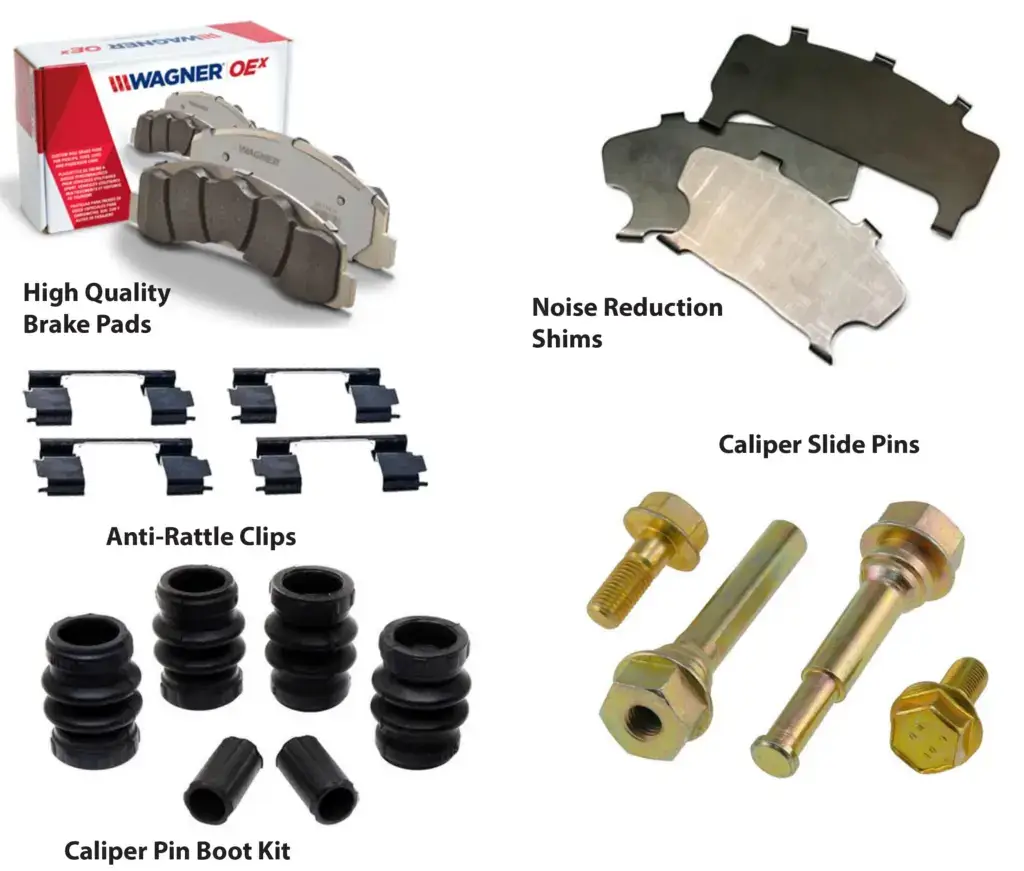Brake job parts list — What you need to do a brake job
Learn what parts and supplies you need to do a complete brake job
So you’re contemplating doing a brake job yourself and want to know what parts you need for a brake job. I’ll give you a complete brake job parts list.
Brake Job Parts List
If you’re working on front disc brakes you’ll need brake pads, noise reduction shims, anti-rattle clips, new caliper pin boots, new rotors, and drag reduction springs (if your car came with them), You may also need new caliper slide pins, if yours show any signs of corrosion.
For more information on what goes into a quality brake job, read this post
Now let’s talk about which brake pads to buy
Brake pads come in three quality levels; economy, OEM, and professional premium grade. You may think you’re saving money by buying economy-grade brake pads. And if you’re driving an old car with a limited life, that might make sense on the surface. But once you dig deeper, you’ll see that buying economy pads almost always costs more in the long run.
Economy brake pads
First, economy pads are simply made with much lower
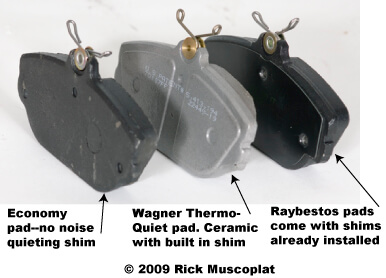
Compare economy and premium brake pads
quality materials. The steel backing plates are made from low-grade steel. Why do you care? Because the brake caliper piston pushes against the middle of the inboard backing plate. The backing plate must spread the pressure evenly across the entire inboard pad and that requires a stiff backing plate made from high-quality steel.
When you buy an economy pad with a low-grade steel backing plate, the plate actually bends in the middle. That causes the center of the pad to wear more than the outermost edges, and because the backing plate flexes, it causes the pad material to crack and fall off. So much for your good deal.
Low-grade steel backing plates also rust faster, so the backing plate “ears” tend to stick in the anti-rattle clips, causing the pad to bind and not release. A rusting backing plate will also debond from the friction material, causing it to crack and fall off.
Next, economy pads usually don’t come with noise reduction shims for the back of the pad. These shims are critical to reducing brake squeal. Even if the shims do come with the pads, they’re usually such low quality, that they don’t reduce brake squeal.
OEM-grade brake pads
Original equipment manufacturer (OEM) grade pads are designed to duplicate the quality level of the brake pads installed at the factory. Depending on the brand, they may or may not include anti-rattle clips and shims. These pads will give good service life equal to the factory pads
Professional premium-grade brake pads
As the name implies, these pads are a step up from OEM grade. They are built with higher-quality friction materials and the highest-quality steel backing plates. They may or may not give you longer pad life, but they will give you smoother braking with less noise.
What type of friction material should you buy
Non-asbestos Organic (NAO)
Semi-Metallic
Ceramic
The pros and cons of NAO brake pads
NAO brake pads were designed to eliminate the health hazards of asbestos pads used before carmakers understood the health hazards of asbestos. They’re a softer pad than semi-Mets, so they’re easier on rotors and they make less noise and create less brake dust. But generally speaking, they don’t last as long. Car makers are phasing out the use of NAO pads. However, if your car came with NAO, you should consider replacing them with either another set of NAO pads or ceramic brake pads.
The pros and cons of semi-metallic brake pads
Semi-metallic pads are filled with steel fibers to draw heat away from the pad and rotor surface. Heat buildup is the enemy of good braking, so car makers use semi-metallic pads in SUVs and trucks to get maximum braking power. However, semi-metallic pads are harder than NAO or ceramic, and they generate much more noise squeal when braking, wear rotors faster, and create the most brake dust. That can make your alloy wheels look dirty brown. DIYers seem quick to substitute ceramic pads for semi-mets to reduce noise and dust. That may seem like good reasoning on the surface, but if the vehicle comes with semi-metallic pads and you install ceramic brake pads, you’re giving up braking power. Ceramic pads will not provide the same brake forces as semi-metallic brake pads.
The pros and cons of Ceramic brake pads
Ceramic pads were designed to offer the smooth and quiet free-braking of NAO pads, but provide longer life. As of 2013, more than 60% of all new cars on the road had ceramic pads from the factory.
There are no Federal standards for aftermarket brake pads or rotors
Car makers must meet rigid Federal standards when designing brakes for a new vehicle. But there are NO Federal standards for aftermarket pads—none. The point here is that no two semi-met or ceramic pads are the same. In other words, ceramic isn’t always ceramic. You can buy a ceramic pad that’s garbage, or you can buy one that’s top-of-the-line. So it all comes back to which grade and brand you’re buying. Here’s a primer on brake pad manufactures
Each of these companies is considered a reputable brake pad manufacturer
Bendix, Raybestos, Monroe, Centric, Wagner, PowerStop, EBC, Bosch, Advics, AKEBONO, Brembo, Ferodo, AC Delco, and Motorcraft,
I don’t recommend buying store brand brake pads or hardware
These brands are considered “store brands” or “private label. ” These auto parts suppliers don’t make their own brake pads. They contract with a large manufacturer to manufacture brake pads and package them under their store name:
NAPA/United, Carquest, Duralast (store brand of AutoZone), Wearever (store brand of Advance Auto Parts), Brake Best (store brand of O’Reilly Auto Parts).
NAPA and Carquest auto parts stores cater to professional auto repair shops and in the past only sold top quality brake parts. However, in order to compete with retail-oriented stores like AutoZone, Advance Auto, and O’Reilly, they now offer economy and professional grades. My personal opinion is that NAPA and Carquest professional-grade pads are every bit as good as the name-brand pads listed above. But I’m not so confident about the retail store brands. I don’t have data to back that up. But my feeling is that if you’re going to pay close to name brand price, why not buy a name-brand part?
Importers
Beck Arnley is an auto parts importer. They source their products directly from OEM manufacturers in Japan and Korea. In other words, you’re usually getting the exact same brake part that you would get from the dealer’s parts department.
Brake Rotors
Just like brake friction materials, rotors also come in several grades. Economy and service grade rotors are built for price-conscious retail customers and shops that sell economy brake jobs. Economy and service-grade rotors aren’t built to the same standards as OEM rotors. First, they’re made with less metal. The photos below illustrate the point. These two rotors are for the same vehicle. One is an economy rotor and the other is a professional-grade rotor built to OEM standards. Notice the difference in weight.
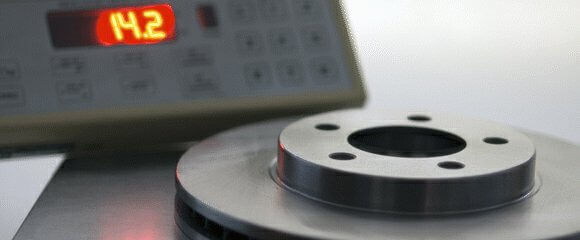
Economy Rotor on scale
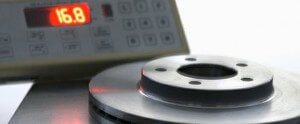
Pro quality brake rotor
In these next photos, you’ll see the difference in the thickness of the “swept area” portion of the brake rotor. The economy rotor is thinner, so it can’t dissipate heat as well as the premium rotor.
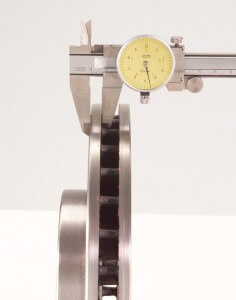
Economy brake rotor. Notice the thinner friction surface
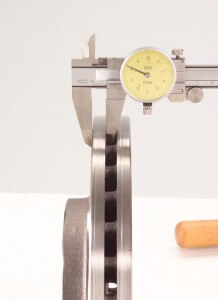
Professional grade rotor. Notice the thicker friction surface
Next, economy rotors don’t have the same number of cooling fins as the car maker or they incorporate a far less effective cooling fin design. As car makers reduce the weight of brake rotors they must compensate by increasing the cooling effectiveness of the cooling fins. So it’s not uncommon to see curved cooling fins and multi-segment cooling fins on OEM rotors. However, since many of those designs are patented and more expensive to produce, economy rotor manufacturers often skip the OEM design and cast in traditional straight fins, dramatically reducing the rotor’s ability to cool.
Finally, economy rotors contain far fewer carbon chains in the raw materials, so they wear faster, create more noise, generate more dust, and wear out friction materials faster.
Brake Caliper Hardware
DIYers often skimp on brake hardware, opting to reuse the factory anti-rattle clips or corroded caliper slide pins. That’s a HUGE mistake. Anti-rattle clips lose their tension due to the high temps created during braking. And they tend to rust. New caliper hardware costs as little as $10 for both front calipers and restores the braking system to its original operation. Simply put, you’re crazy not to replace these inexpensive, yet critical brake parts.
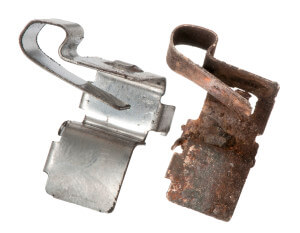
New versus rusted anti-rattle clip
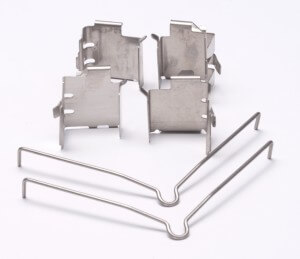
Full set of caliper hardware
The same rule applies to caliper slide pins. Corrosion on the slide pins prevents the caliper from releasing quickly. That causes brake pad drag, uneven pad wear, and dramatically reduced pad life. Brake caliper slide pins are cheap. Clean off the old grease and examine the old pins. If they show any signs of corrosion or wear, replace them with new pins.
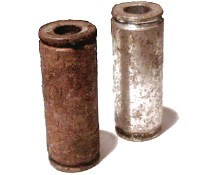
Corroded slide pins
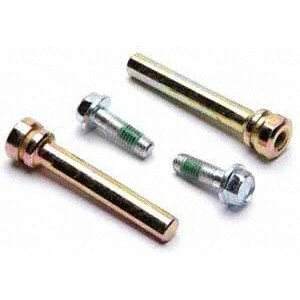
Drum brake parts
Aside from buying a name-brand set of brake shoes, you’ll also need a new hardware kit. The kit comes with new springs and hold-down hardware. Don’t be foolish and try to reuse the old springs. They’re heat-soaked and have lower tension. They’re also rusted. If one breaks, it can destroy your entire brake job.
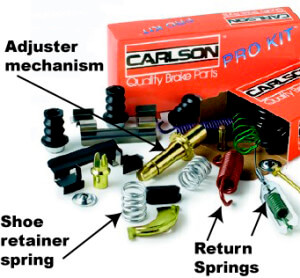
Drums: See the discussion on brake rotor quality above. The same rules apply to brake drums.
Brake job parts list — Supplies
For disc brake jobs you’ll need
Synthetic high-temperature brake grease
Moly grease
See these posts for in-depth information on which brake grease to use and where to apply it
Hub cleaning tools See this post for a list of hub cleaning tools
©, 2015 Rick Muscoplat
Posted on by Rick Muscoplat

